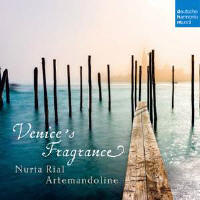Texte paru dans: / Appeared in: |
|
|
Outil de traduction (Très approximatif) |
|
|
Reviewer: David Vickers A title that evokes wafting scents on the breezes of La Serenissima, a cover photo of a hazy San Giorgio Maggiore taken from the Riva degli Schiavoni, and plenty of charming music involving multiple Baroque mandolins – what could possibly be more Venetian? Well, for a start, most of the music. Five arias sung sweetly by Nuria Rial are from works written for Vienna by composers from Florence (Conti), Naples (Manna), Parma (Traetta) and Dresden (Lotti, a Venetian guest in Saxony). Moreover, a quicksilver E minor Sonata for mandolin, violin and continuo is by Carlo Arrigoni – a Florentine who spent a few years in London during the mid-1730s and later composed works for Vienna. Only one aria by Galuppi and two Vivaldi concertos are bona fide Venetian pieces. Shallow foundations are shaken further by a booklet note dominated by irrelevances and that offers nothing whatsoever about historical contexts, dramatic functions and musical attributes of the six arias (character names are not given with the sung texts). Among several glaring errors, Arrigoni cannot have played mandolin in Handel’s Alexander Balus because he had died four years before its premiere! Happily, the music-making offers manifold pleasures. Artemandoline’s vivacious single strings and multiple plucked continuo (mandolins, guitar, theorbo and harpsichord) swamp Rial’s limpid singing in ‘Bella armonia vieni’ from Traetta’s serenata Le feste d’Imeneo but the balance between zesty instrumentation and radiant voice is spot on in ‘Rosa e Lilio’ from Galuppi’s oratorio Jahel. Pairs of concertante mandolins and barytons (viols) contribute a unique texture in ‘Dei colli nostri’ from Conti’s Il trionfo dell’amicizia e dell’amore. ‘Finché spera che le rieda’ (Conti’s L’Astarto) has lilting charisma. The imprisoned Adelberto’s lament ‘Lascia che nel suo viso’ from Lotti’s Teofane, accompanied by obbligato mandolin and simple continuo, has melancholic beauty (the final phrase containing a top D has been discreetly excised). Anonymous variations on ‘La folia’ outstay their welcome but Vivaldi’s double mandolin concerto (RV532) has delectable shading from soloists (and co-directors) Juan Carlos Muñoz and Mari Fe Pavón, supported by gossamer-like pizzicato strings in the Andante. |
|




